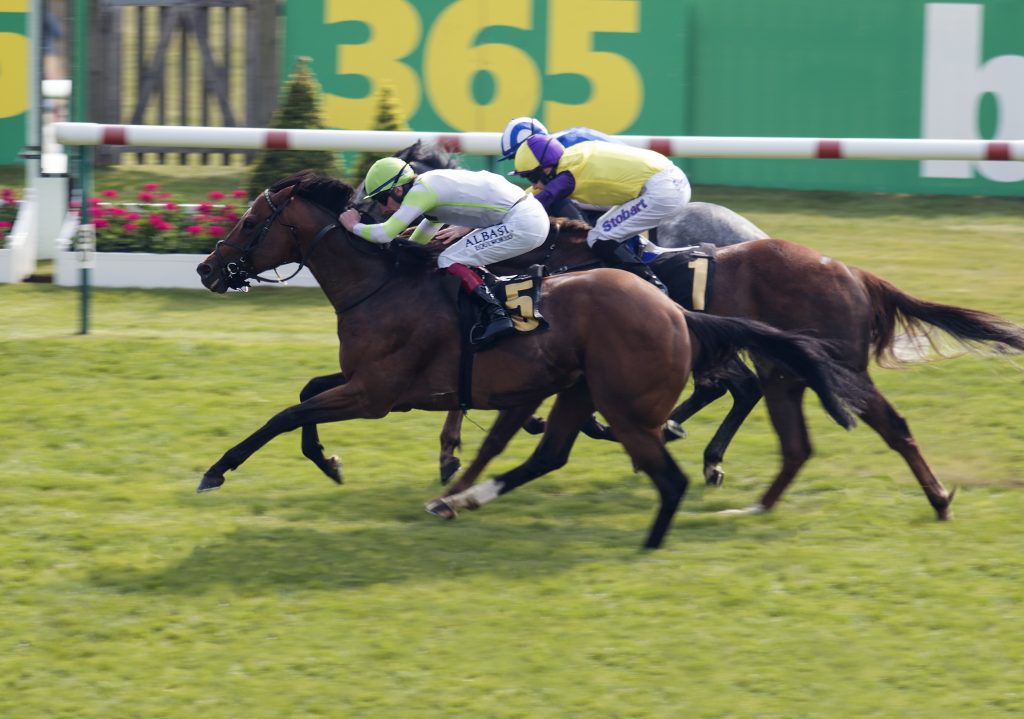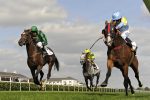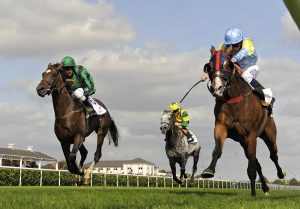After 25 years as a trainer you enjoyed your first Group winner in April when Keystroke caused a 66-1 upset in the Abernant Stakes. What did it mean to you and the team at Diomed Stables?
We haven’t run many horses in Group races and it’s a great thrill to win one at any stage. I started with four horses and have built up to 60 now and landing a Group 3 on our home track was a fantastic feeling – definitely the highlight of my training career so far.
When you have a string of our size you never go into races like that expecting to win, just hoping your horse will run above its mark. Keystroke is a high-class horse and I had hoped he’d perform well. Any win gives you a lift and a great feeling of satisfaction, but that was above the norm and we enjoyed a good celebration afterwards.
When Keystroke joined you, he had yet to race at six furlongs and was campaigned mostly on the all-weather. Did you always have it in your mind to reinvent him as a turf sprinter?
Before Keystroke came to me, I’d saddled runners against him on the all-weather and he looked to me like a horse with plenty of speed. When the owners asked me if I’d like to train him, I jumped at the opportunity and straight away thought we ought to try him over six furlongs.
After he’d won first time I didn’t want to go to the all-weather finals because I didn’t think Lingfield would suit him – that left us with very few options on the all-weather. I had no reason to believe he wouldn’t be as good on turf and suggested the Abernant to the owners, GG Thoroughbreds, who were right behind me.
With their blessing, I have entered Keystroke in the Diamond Jubilee at Royal Ascot. He is still an entire and a very good-looking horse – in the back of the owners’ minds, eventually they’d like him to take up a stallion job somewhere.
You have a reputation for making shrewd purchases, particularly at the horses-in-training sales, which seems your preferred hunting ground for new recruits. What’s the appeal over other types of sale?
We can’t compete with the big owners at the yearling sales, but at the horses-in-training we can; the difference being the big owners are selling at the horses-in-training and not buying. If I had the owners to compete at the yearling sales, I’d be there but we just haven’t, moneywise. You pretty much have to have an oil well or be Coolmore to buy at present-day prices.
“The beauty of Newmarket hits you when visiting owners come from miles away”
At the horses-in-training sales we have been lucky enough to find a few rough diamonds we can polish up a bit. Realize is one we picked up for not big money; he won four for us and we had some fun with him. There’s no secret: do your homework, watch the horses and make a judgement.
Born and bred in Newmarket and, having ridden out there as a schoolboy in the 1970s, you must have seen a lot of changes at the HQ of British Flat racing. What has been the best?
The management of the Heath. We used to have only a six-month season and there was an off-season when all the horses would trot round the roads, hardly any went on the Heath in winter. Now we race all year round and the gallops are so well maintained for the amount of use they get. The grass gallops haven’t changed that much, but the introduction of the all-weathers, horsewalks with rails everywhere make a big difference.
When I started riding out on the Heath there wasn’t a rail in sight. If a horse got loose it went anywhere; the safety aspect has improved no end. Also, the fact Sheikh Mohammed’s racing interests are based here has made a big difference to the town; the studs he has transformed now boast world-class facilities. In the 1970s there were only two or three top stallions in the town, now there are many fantastic stallions here.
When you’re on the Heath every day you’re inclined to take the place for granted, and the beauty only really hits you when visiting owners come here from miles away. The whole experience is jaw-dropping for them.
In your early days there were 800 horses in the town. Now there are some 3,000. How do you and the other trainers cope, getting to and from the gallops every morning?
I cope easily because Diomed Stables backs onto Racecourse Side, whereas most of the trainers go over to Warren Hill. We have very few trainers who stay on this side of town on a permanent basis.
I am one of those and we don’t have congestion problems; it’s out of the back door straight on to the gallops. But the other side of town can get very crowded. The trainers with 100-plus battalions are based on Bury Side.
I love the Flat gallop, the Summer gallop and Peat Moss on the Racecourse Side – fantastic facilities that would rival any gallops anywhere.
Such an increase in numbers presents other problems, including finding enough stable staff. What do you see as the crux of the staffing problem?
Basically, there is a lack of indigenous population that ride horses when they are young. It is very difficult to get people to come into this industry after school. Successive governments encourage children to stay on at school for longer and I think this is an industry where you need to get the bug early.
Very few people are able turn their hand to it once they hit 20; they need to start riding racehorses when they are younger. More is being done through Racing To School, where they take schoolchildren to the races and try to make the sport part of their education.
Short term, I don’t think there is an answer, apart from bringing in people from abroad. If we can convince the government we are an under-staffed and a skilled industry, they might let us employ skilled workers from overseas. How racing is classed an ‘unskilled’ industry I do not know. Riding a racehorse and bringing out the best in it requires great expertise and a lot of technique.
Having trained since 1994 in Newmarket from Graham Lodge, Trillium Place and now Diomed Stables, have you enjoyed a steady upgrade in facilities?
Both Graham Lodge and Trillium Place were fantastic places to train. The difference is we have a bit more room at Diomed. We have turn-out, horsewalkers, a treadmill, a menage. I feel privileged to have been lucky enough to have trained in all three yards.
Ben Hanbury trained from here and produced Midway Lady [1,000 Guineas and Oaks] and Kala Dancer [Dewhurst]. The narrative of Newmarket means a lot, the place where racing started in this country and Charles II rode out on the Heath.

Keystroke (nearside) edges out Yafta and Brando (middle) to win the Group 3 Abernant Stakes – Photo: George Selwyn
Are owners’ syndicates the answer when it comes to competing with the big battalions who spend millions at the sales?
A lot more needs to be done to look after the members of owners’ syndicates. At the moment I think they get the short end of the stick at most racecourses. They must be made to feel welcome and that they are getting a good deal. Racecourses are reluctant to give masses of badges and look after big syndicates, and, in fairness, are probably not in a position to do so.
I don’t think there is any formula where you’d have huge syndicates trying to take on Coolmore and Godolphin, they couldn’t do it. There just aren’t that many owners. Even though we are the second biggest spectator sport in the country we are still a minority sport.
You have trained winners on every Flat racecourse in Britain and enjoyed your best year in 2018 with 58 wins. Have you any plans to expand your business?
I don’t really want to grow the numbers of horses we have here, but we’d like to up the quality. That’s what we try and do every year. I don’t want to become a manager and that’s what I’d be if we have many more horses; not hands-on as I am now. Overseeing the training is the part of the job I enjoy most. Give me a choice of where I’d like to run my horses, it would always be Newmarket.
“It is very difficult to get people to come into this industry after school”
Travelling is one of the worst parts of a trainer’s life and we can avoid that on our two unique tracks. The July Course, with its summer atmosphere, is totally different to the Rowley Mile and having them on our doorstep is a big advantage.
The statistics reveal you have had more runners on the all-weather than turf in the past five seasons. Is this an intentional part of the Stuart Williams business model?
The increase in prize-money that came with the advent of the all-weather finals meant that the races on the all-weather are now on a par with similar turf races – it makes sense to target them. Particularly when only about 50% of the trainers chase the all-weather money and, with only half the trainers competing, it makes it easier to win equivalent prizes on the all-weather.
The top ten trainers on the all-weather include some of the biggest in the country, Mark Johnston, John Gosden and William Haggas, to mention just three.
You were president of the National Trainers Federation in 2011. Are you still on the NTF Council and is lack of prize-money still the biggest bone of contention?
I am not on the National Trainers Federation Council any more. I took a back seat after we had a row about prize-money and tariffs. It was at the point where we put in prize-money agreements which had never been done before, so we had made some progress. But that progress dissipated a bit. I did the best I could.
Lack of prize-money is a huge problem across the board; even in the Group races we are slipping behind other jurisdictions. I would think Newmarket is one of the most expensive places in the world to have a horse in training so we need the prize-money, and if it isn’t there you can’t win it.
We need to be racing for a minimum of ten grand a race. Courses like York and Chester have this minimum £10,000 prize-money structure in place already. Extra prize-money would be available with a Tote-based system.
We are not going to get rid of the bookmakers, and I wouldn’t want to. But if we had a system similar to Australia’s – bookmakers on-course and Tote off-course – it would go a long way to solving some of the ills we are suffering.
What can the industry do to improve both the retention and recruitment of owners?
We have got to look after owners better as a whole. We rarely have owners coming to the yard, so the only time we meet them is at the races. Statistically, most of the time they are not going to win, so we need to make sure they are getting value for money at the races.
“You need to love horses and love what you do”
The most likely person to be my next owner is the guy who comes racing with his or her pal who owns one of the horses and enjoyed the day. Hopefully his or her next question is, ‘How do I get into the game?’ While the situation has improved, some courses are sadly lacking in providing ‘an owner experience’ that encourages them to come back.
What is the most challenging part of your job – and the most satisfying?
Finding the right staff and keeping them. We are trying to compete with the big stables and cannot pay the same wages. So we try to do things differently to get to the same point, which is taking the horses to the races in the best possible condition.
We ride six lots a morning, whereas other yards might have only four or even three. But most of our riders only ride and are not mucking out, doing the waters or the hay.
The money is not bad now, but working in a yard you need to buy into the fact that it’s a way of life. You need to love horses and love what you do. The most satisfying part of the job is being in the winner’s enclosure with a horse that you have nurtured from a young age. That’s the ultimate.
In your early days you worked for Newmarket trainers Bill O’Gorman, Ron Sheather and Alex Scott, as well as Bart Cummings in Australia. Is there one modern-day rival you particularly admire?
Anyone who can survive in this business has my admiration because it is so tough and demanding trying to maintain standards at the top, and keep your head above water at the bottom end.
The logistics of organising the big yards is absolutely amazing – the Faheys, Hannons, Gosdens and Johnstons. It is mind-boggling how they have so many runners at different meetings in a day. And they still keep winning!



